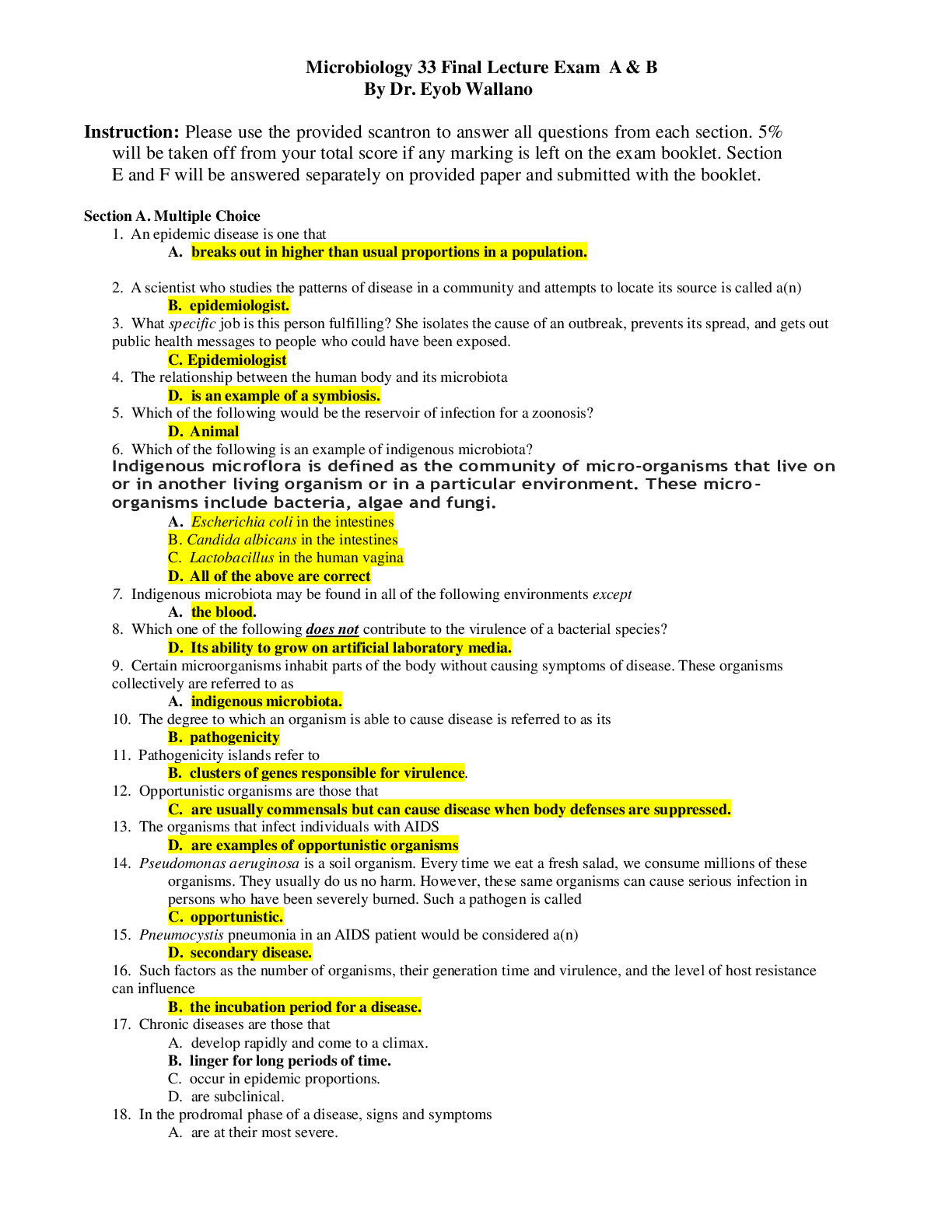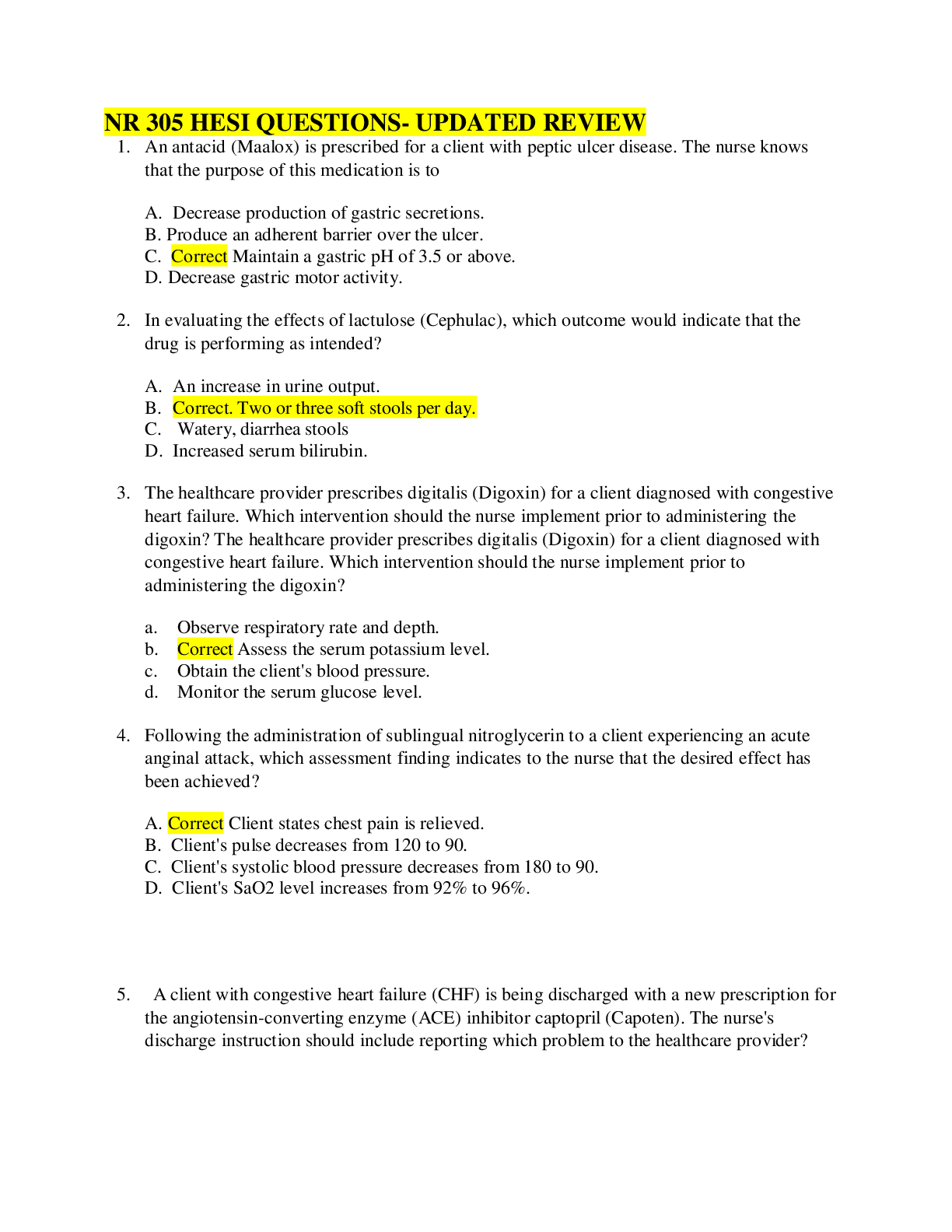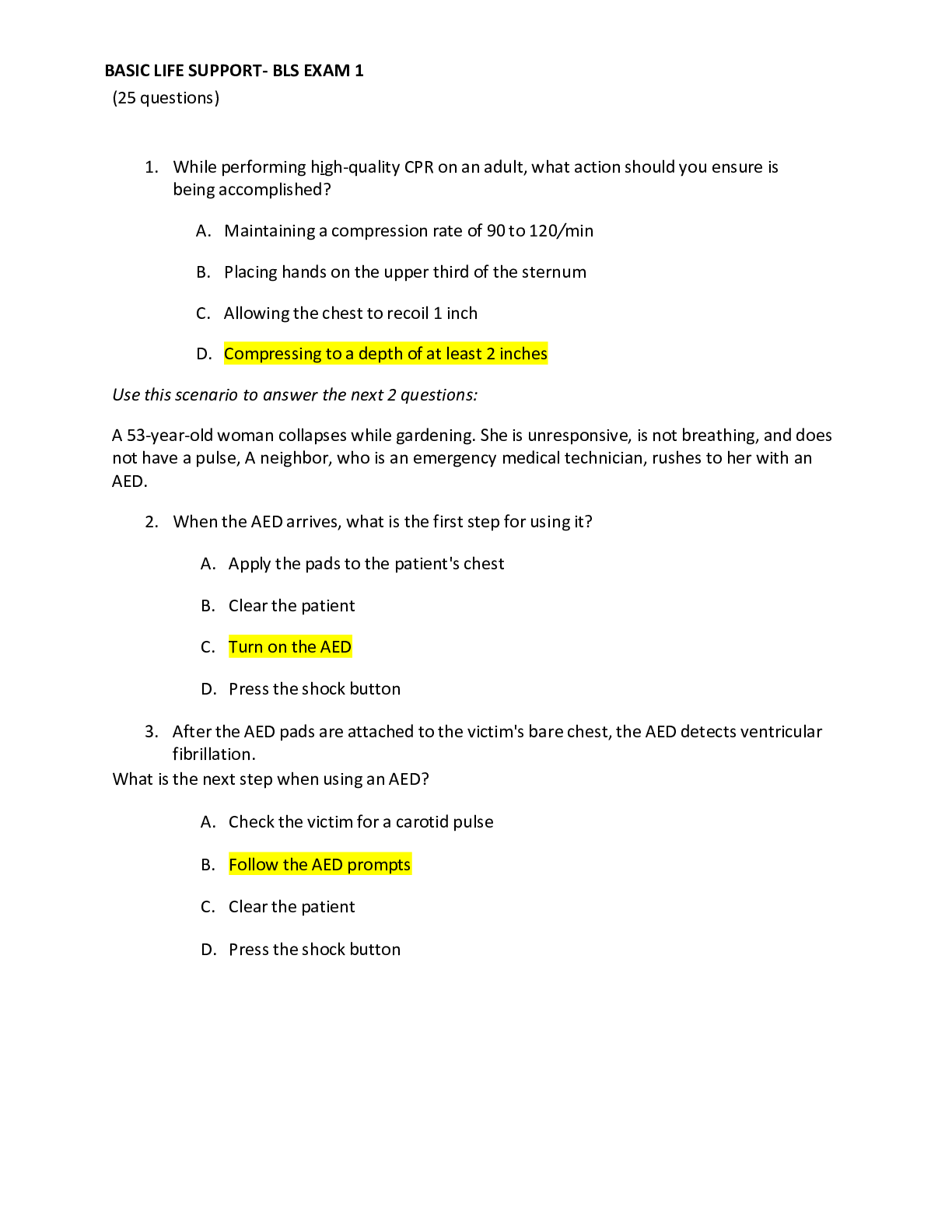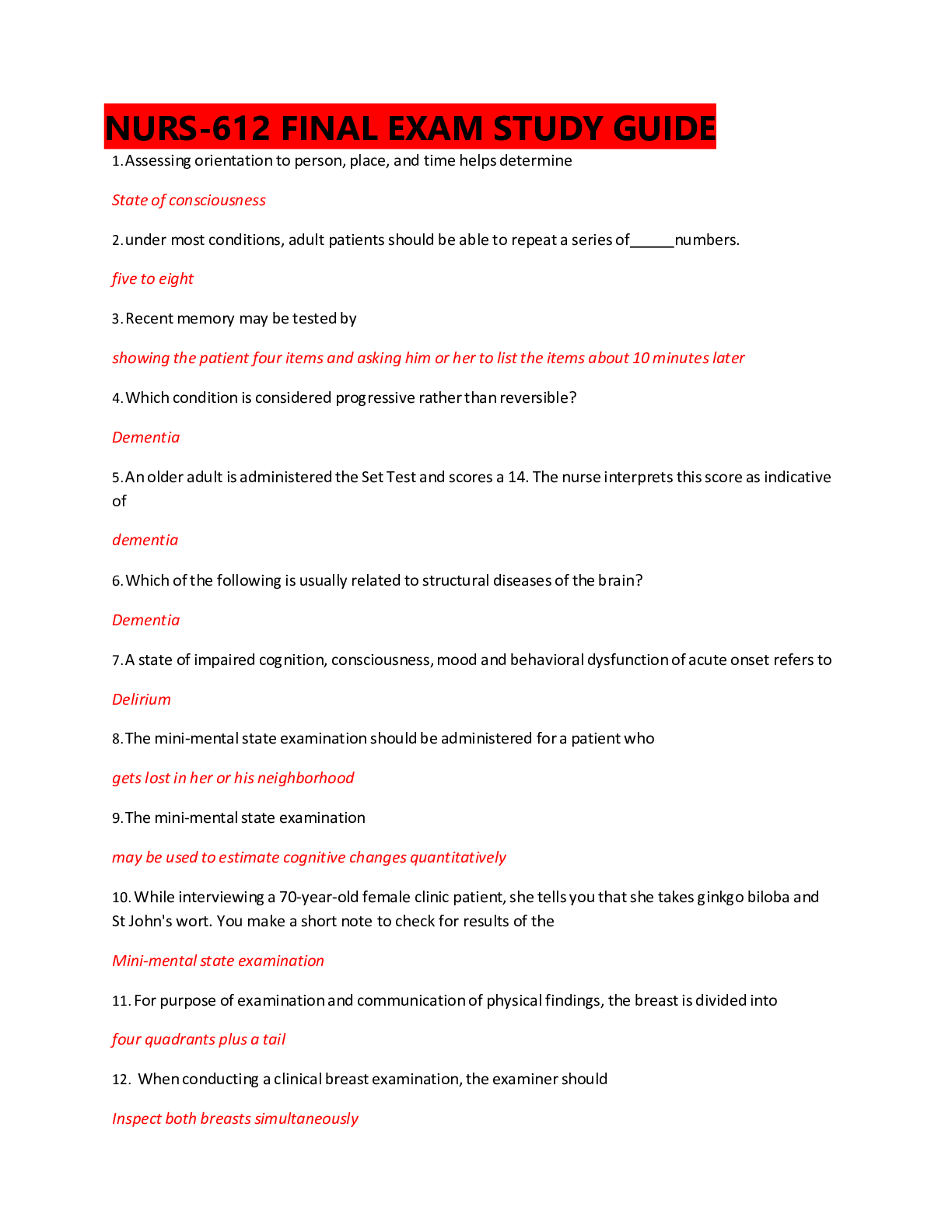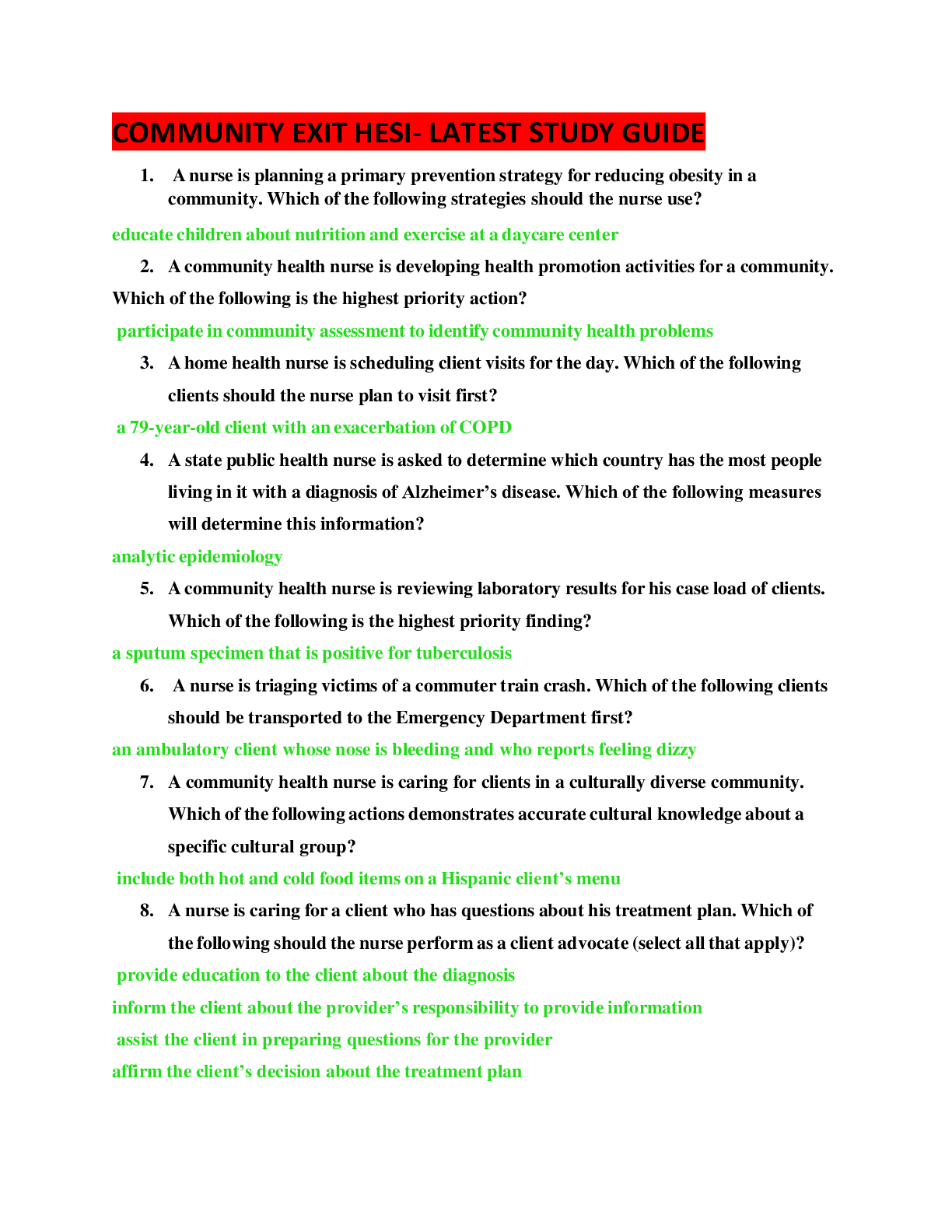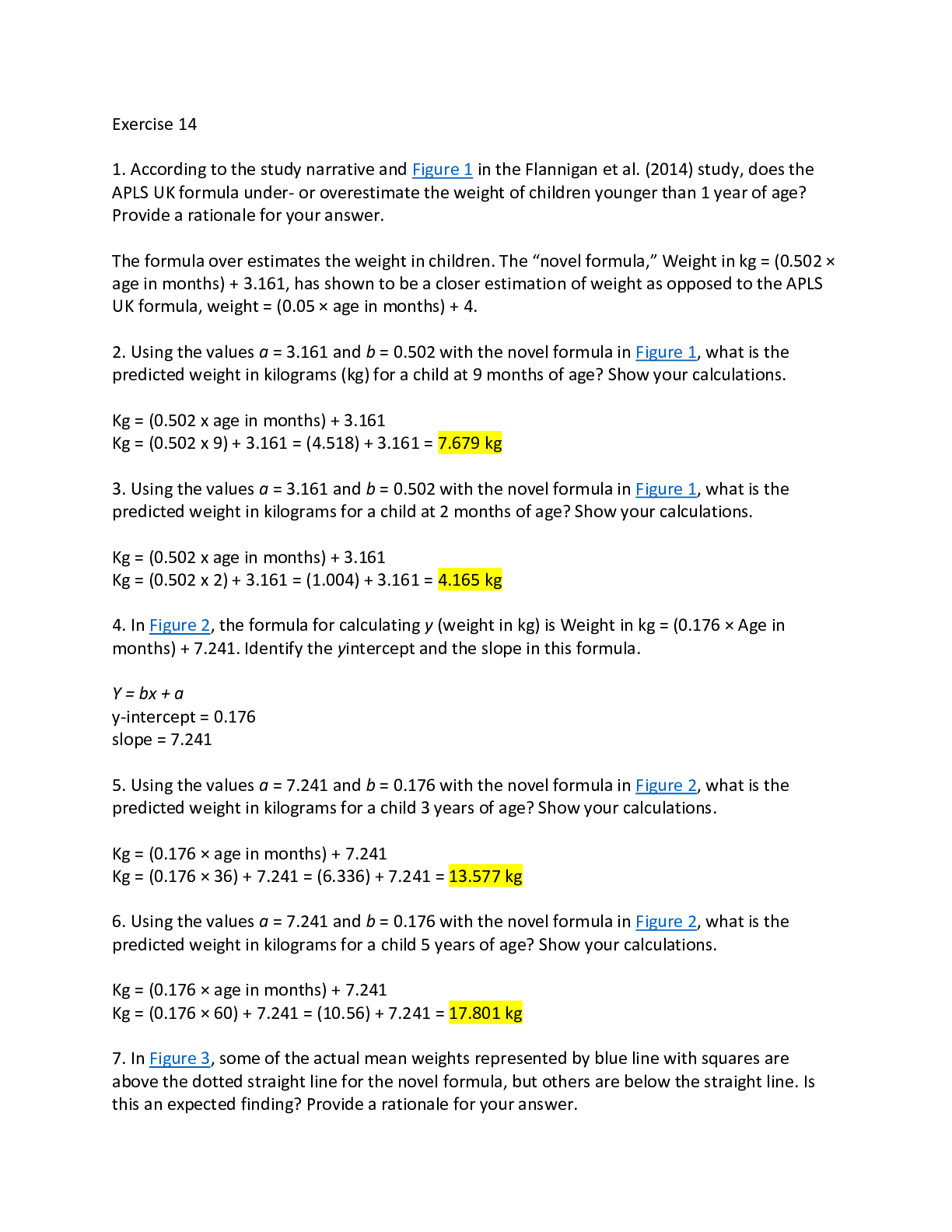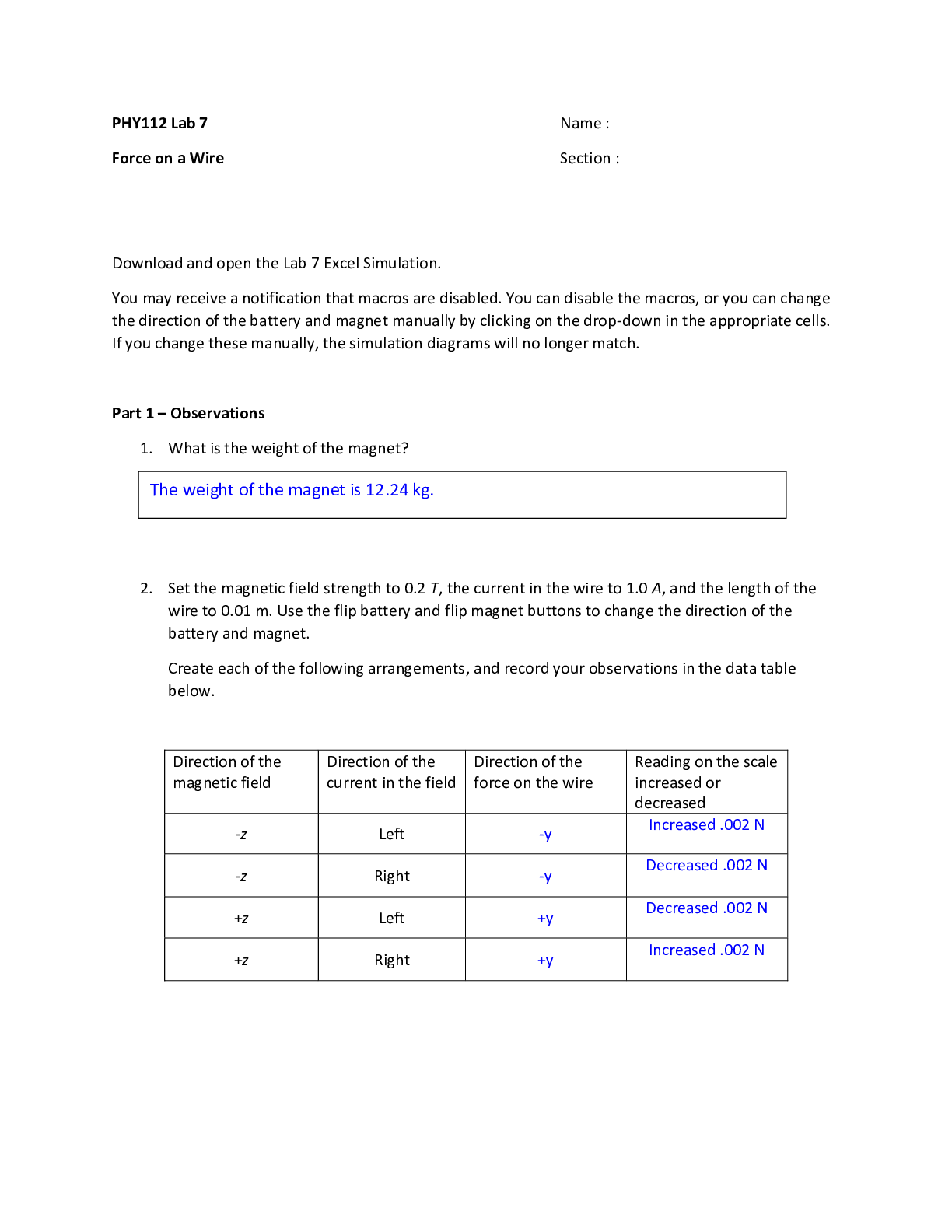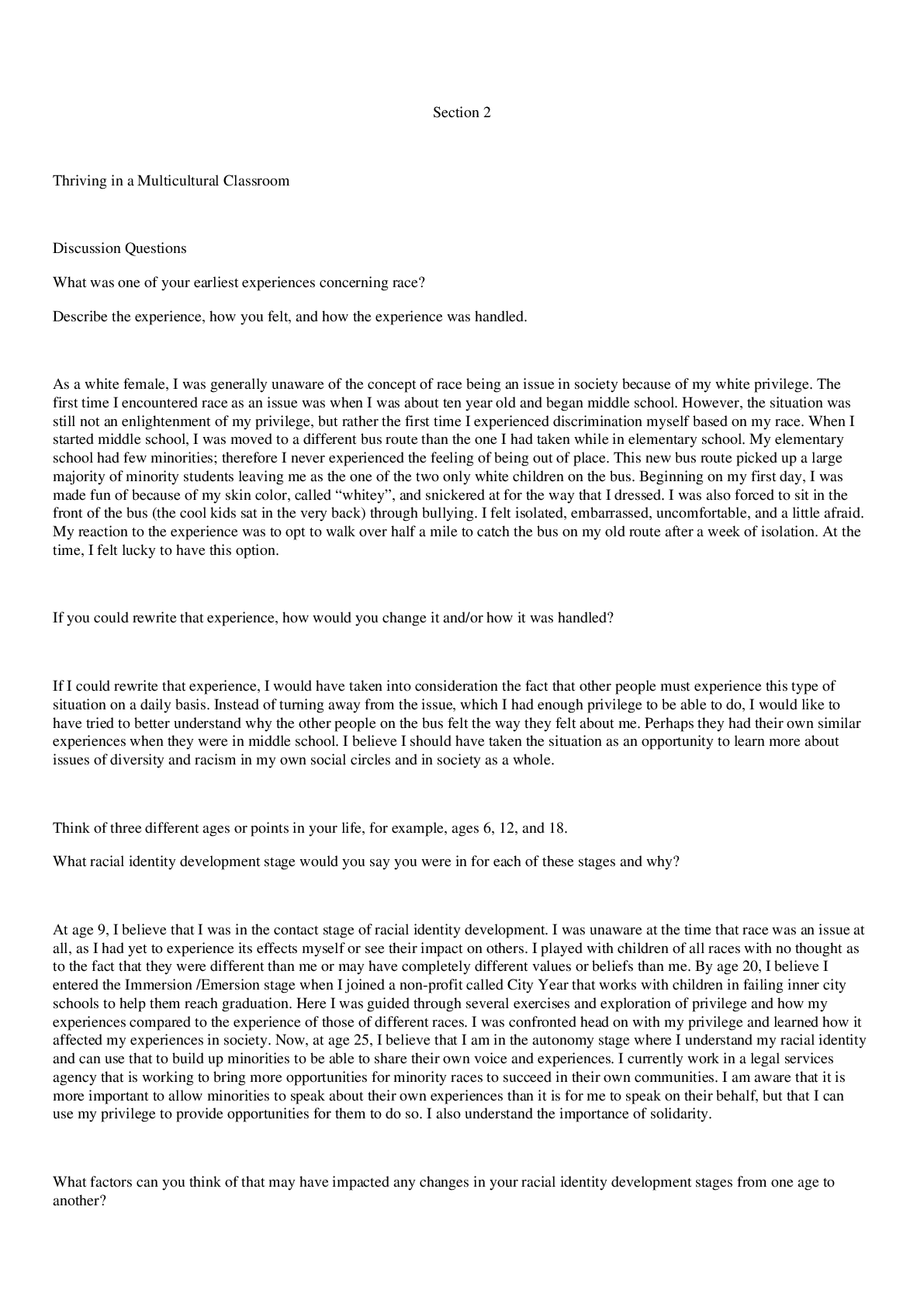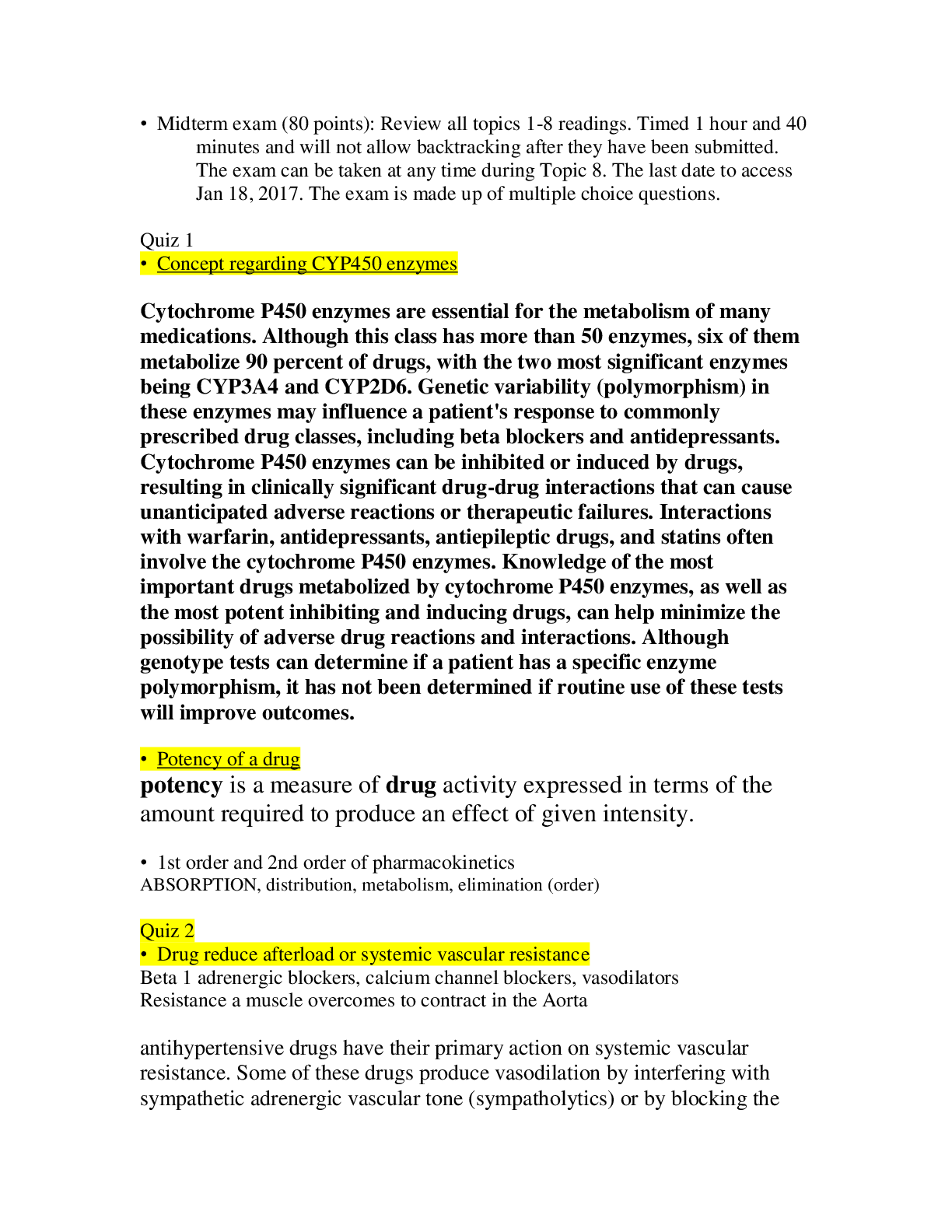*NURSING > STUDY GUIDE > MEDSURG UPDATED PRACTICE A (All)
MEDSURG UPDATED PRACTICE A
Document Content and Description Below
MEDSURG UPDATED PRACTICE A 1. The nurse cares for the client diagnosed as being in the manic phase of bipolar disorder. Which behavior indicates to the nurse the client condition i... s improving? a. The client offers suggestions to other clients on the unit b. The client begins to write a book about life c. The client sits and eats with other clients on unit d. The client talks with other clients a group meeting 2. The health care provider orders a continuous intravenous aminophylline infusion for a two year old client. It is most important for the nurse to intervene for which situation? a. The client heart rate is 100 bpm b. The clients blood pressure is 100/60 mmHg c. The clients serum theophylline level is 25 mcg/mL d. The client is sleepy 3. The nurse teaches the client about the schedule cardiac catheterization. Which statement, if made by the client to the nurse, indicates that the teaching was effective? a. "I understand that there is little or no risk associated with this procedure." b. "I may experience a little pounding sensation in my chest during the procedure." c. "I will be in and out of the procedure room in about 30 minutes." d. "I will be able to walk in the hall soon after the procedure is completed." 4. During the second stage of labor, the client's partner asks the nurse, "Can I go get a cup of coffee from the cafeteria?" Which response by the nurse is best? a. "I will get you a cup of coffee." b. "It would be best if you stayed here at this time." c. "Ask your partner if it is acceptable to leave." d. "Why do you want to leave the room?" 5. The nurse discovers that client lying face down on the floor. Which action does the nurse take first? a. Assess the patency of the client's airway b. Determine whether the client is responsive c. Check the client's carotid pulse d. Reposition the client onto the back 6. A nurse works 3 weeks at a 100-bed suburban hospital after working several months at a 40-bed rural hospital. The nurse prefers the total client care delivery system that was used at the rural hospital, rather then the team leading system of client care that is used at the suburban hospital. Which action does the nurse take? a. Works with in the system at the hospital to change the type of client care delivery b. Discuss his thoughts about the type of client care delivery system with the nurses supervisor c. Asks the nurses peers why this type of client care delivery system is used d. Suggests a change in the type of client care delivery system to the director of nursing 7. The nurse cares for the client diagnosed with a left traumatic below knee amputation (BKA) with a tourniquet in place. The client also has a tear from the perineum to the rectum. Which action is the nurse take first? a. Apply anti-shock trousers b. Assesses the clients level of consciousness c. Remove the tourniquet d. Check the client's blood pressure and pulse 8. During morning rounds, the client diagnosed with schizophrenia tells the nurse, "I know you are conspiring with my spouse to keep me locked away." Which statement by the nurse is the most appropriate? a. "What makes you think your spouse is trying to hide your existence?" b. "Are you saying that you think your spouse doesn't love you?" c. "I can see that you are frightened about being here but I am a nurse in a hospital." d. "I'm not conspiring with your spouse. I first met your spouse when you are admitted to the hospital." 9. During a routine prenatal visit, the nurse auscultates the fetal heart rate (FHR). If the fetal position is left sacrum posterior (LSP), at which site does the nurse expect to find the fetal heart (FHT)? a. Below umbilicus, on the mothers right b. Below umbilicus, on the mothers left c. Above umbilicus, on the mothers left d. Above umbilicus, on the mothers right 10. The nurse makes environmental rounds on the client care unit. Which problem does the nurse addressed first? a. A wheel of the medication cart is broken b. The needle disposal unit in unoccupied room is full c. The call light and occupied isolation room is broken d. The ice machine and the visitors lounge is leaking water on the floor 11. The nurse observes a nursing assistive personnel (NAP) enter the room of the client diagnosed with tuberculosis (TB) to provide morning care. Which observation, if you made by the nurse, does not require an intervention? a. The NAP enters the room while wearing goggles and a hair covering b. That NAP enters the room while wearing a mask and sterile gloves c. The NAP enters the room while wearing a gown and clean gloves d. The NAP enters the room while wearing a particulate respirator and a gown 12. The nurse teaches the client about ferrous sulfate. Which statement by the client indicates to the nurse that the client understands the education? a. "I should take this medication when I take my antacid." b. "I should take this medication with orange juice." c. "I should increase my intake of foods that contain calcium." d. "I should take this medication at bedtime." 13. The nurse gives discharge instructions about home care for orchitis to the client. Which statement indicates to the nurse that teaching has been successful? a. "I should make an appointment to have a circumcision." b. "It will help if I use a scrotal support." c. "I should restrict my athletic activities for about 6 weeks." d. "I need to stay in bed for at least 10 days." 14. The nurse cares for the client having a left total hip arthroplasty period in which position does the nurse placed the client after surgery? a. Legs abducted with the toes pointing upward b. Legs adducted with a bed cradle in place c. Flat on the bed with a foot board in place d. Legs elevated on two pillows with the knees flexed 15. The adolescent receives 10 units of intermediate-acting insulin every morning at 0700. If the client requires the insulin dosage reduced, the nurse expects the client to present with which symptom? a. Declines lunch at 1200 b. Reports hunger at 0900 c. Experiences confusion at 1600 d. Becomes sleepy at 2100 16. The nurse discovers the client in the bathroom attempting self-harm. Which action does the nurse take first? a. Removes the client from the bathroom and escorts the client to the bedroom b. Stays with the client and continually monitors for self-destructive behaviors c. Initiates a discussion with the client concerning reasons for self-harm d. Distracts the client from trying to hurt self by talking about the family. 17. The nurse admits a 2-month-old infant for surgical correction of hypospadias. Which assessment does the nurse complete? a. Check this scrotal sac and palpate the testes b. Inspect the position of the urinary meatus c. Obtained a urine sample for analysis d. Measure intake and output hourly 18. The patient of an 18 month old toddler ask the nurse, (Which toy is most appropriate for my child?) The nurse from recommend which toy? a. A story book b. A stuffed animal c. A colorful mobile d. A large yo-yo 19. The nurse cares for the client prior to cataract surgery. The nurse administers the preoperative medication. Ten minutes later, the nurse finds the client on the floor at the foot of the bed. Which action does the nurse takes initially? a. a. Notifies the healthcare provider, and receive new orders b. b. Complete accident report documenting the fall c. c. Stays with the client and calls for assistance d. d. Moves the client back onto the bed providing support to the cervical area 20. The nurse teaches the client what to expect during a cardiac catheterization. Which statement if made by the client, indicates further teaching is necessary? a. "I may feel a fluttering sensation in my chest during the test." b. "I may kill chest pain during the test." c. "I may have chest pain for several days following the test." d. "I may have some pain at the catheter insertion site." 21. The parents of the 18 month old toddler with a fractured femur visits with the child in the hospital. The parents say they must go home, the child screams, cries, and hits the parents. Which statement does the nurse suggest the parents tell the child? a. "We will return in a little while." b. "We will come back at 1000 hours." c. "We will return when the sun comes up." d. "We will come back as soon as we can." 22. The nurse supervises a nursing assistive personnel (NAP) caring for the client after abdominal surgery. Which observation requires an intervention by the nurse? a. a. The NAP massages the client's leg using long, firm strokes b. b. The NAP massages the client arms using smooth, gentle strokes c. c. The NAP assist the client to put the joints through range of motion exercises d. d. The NAP positions the client side-lying and applies lotion to the back 23. The nurse cares for the client diagnosed with anorexia nervosa. Which goal is the highest priority initially? a. Stabilize the clients weight b. Encourage the client to gain insight about body image c. Maintain the clients fluid and electrolyte balance d. Increase the clients caloric intake 24. The nurse administers medications to the client diagnosed with bipolar disorder. The client approaches the nurse and begins to throw things. Which action does the nurse take? a. Get another nurse to assist with the client b. Give the client the medications, so the client will calm down c. Admonishes the client, and suggested the client collect self d. Sits down and asks the client what is bothering the client 25. The nurse prepares to assess the blood pressure of the six year old child following an accident. A blood pressure cuff of appropriate size is unavailable. Which action does the nurse take? a. Uses another site appropriate for the size of the bailable cost to obtaining reading b. Wait until proper equipment is available before proceeding to check the blood pressure c. Use a smaller blood pressure cuff and checked to reading in both arms d. Uses a larger cost, and add 10 mm Hg to the systolic reading 26. The healthcare provider orders tobramycin for a 3-year-old child. The nurse enters the clients room to administer the medication and discovers that the child does not have an identification bracelet. Which action by the nurse is the most appropriate? a. Ask a coworker to identify the child before giving the medication b. Ask the parents at the child's bedside to state their child's name c. Hold the medication until an identification bracelet can be obtained from the admitting office d. Ask the child to save the child's first and last name 27. The nurse changes the dressing on a client two days after a bowel resection. After opening a sterile pack and putting on the sterile gloves at the clients bedside, the nurse notes the dressing needed for the dressing change are missing. Which action does the nurse take next? a. Remove the gloves, obtained the missing dressings, and replaces the clubs to continue with the procedure b. Closes the pack, obtained the missing dressing and new gloves, and reopen the pack to continue with procedure c. Presses the call light, ask the nurse assistive personnel to bring the missing dressings to the clients room, and then continues with the procedure d. Remains in place at the clients bedside while the nursing assistive personnel obtains the missing dressings, and then continues with the procedure 28. 29. The client receives parenteral nutrition (PN) via the internal jugular vein. Which action does the nurse take if the next container of PN solution is not available when it is needed? a. Slows down the PN infusion until the new solution is available b. Hangs a container of 0.9% NaCl until the new solution is available c. Hangs a container of 10% D/W until the new solution is available d. Uses a heparin lock until the new solution is available 29. The nurse cares for the client with a history of chronic alcohol abuse, nutritional problems, and confabulation. In planning for the clients nursing care, which action is the first priority of the nurse? a. Restrict visitors to minimize environmental stimuli b. Provide a high-calorie, high- protein diet as ordered c. Start a intravenous line of D5W with thiamine as ordered d. Monitor behaviors for documentation of confabulation 30. The nurse cares for the school- aged Child diagnosed with cystic fibrosis (CF). The healthcare provider orders aerosol therapy. The nurse knows which is the expected outcome? a. The child's appetite improves b. The child displays no evidence of infection c. The child manages respiratory secretions without difficulty d. The child's activity level increases 31. Which situation suggests a nurse is addicted to the use of alcohol or habit-forming medications? a. The nurse questions a client's medication order left by a healthcare provider b. The nurse volunteers to "Float" to another unit at the hospital c. The nurse cannot be found on the unit for half an hour during the assigned shift d. The nurse questions a client about paying before administering a narcotic analgesic CONTINUED.................................DOWNLOAD FOR BEST SCORES [Show More]
Last updated: 2 years ago
Preview 1 out of 25 pages
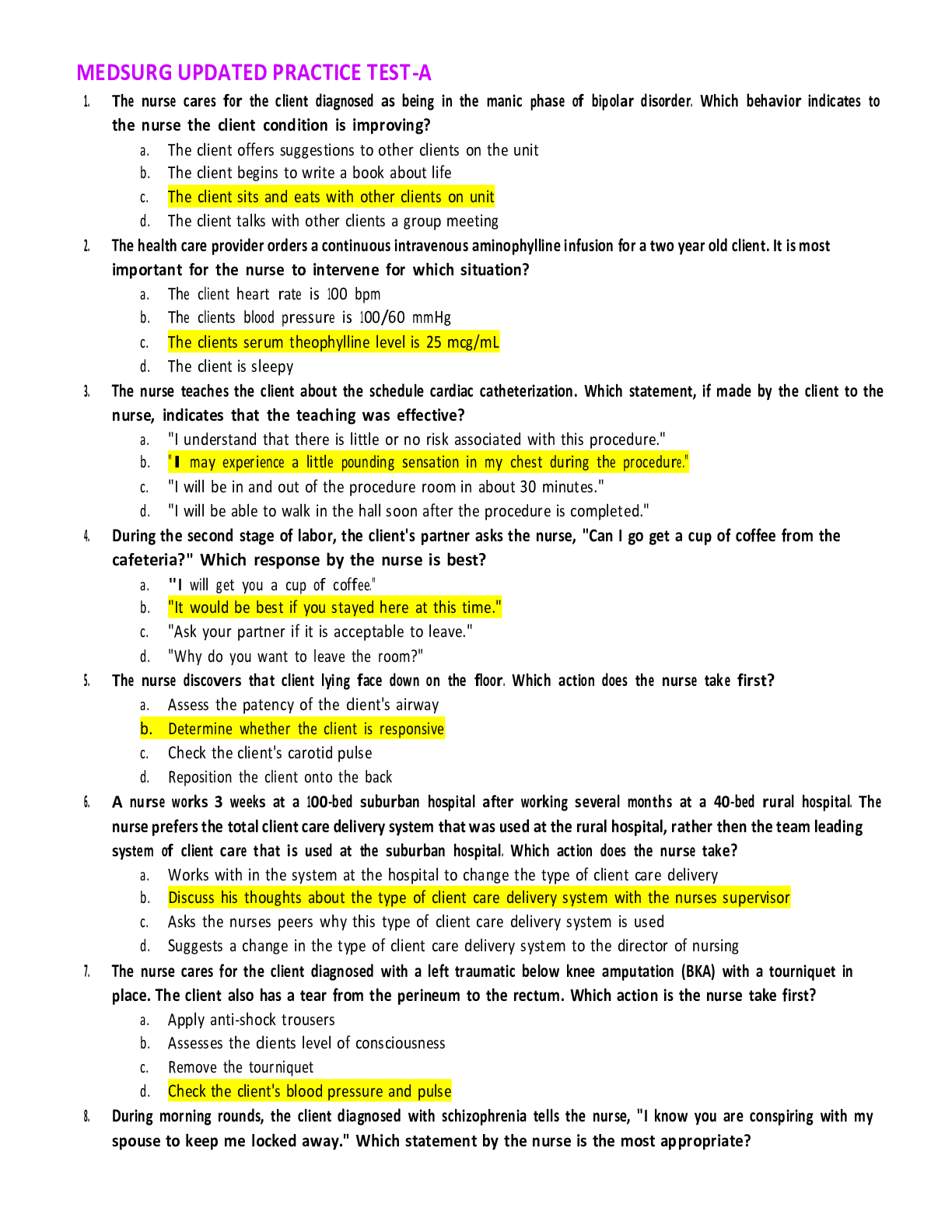
Buy this document to get the full access instantly
Instant Download Access after purchase
Buy NowInstant download
We Accept:

Reviews( 0 )
$13.50
Can't find what you want? Try our AI powered Search
Document information
Connected school, study & course
About the document
Uploaded On
Feb 15, 2022
Number of pages
25
Written in
Additional information
This document has been written for:
Uploaded
Feb 15, 2022
Downloads
0
Views
149

